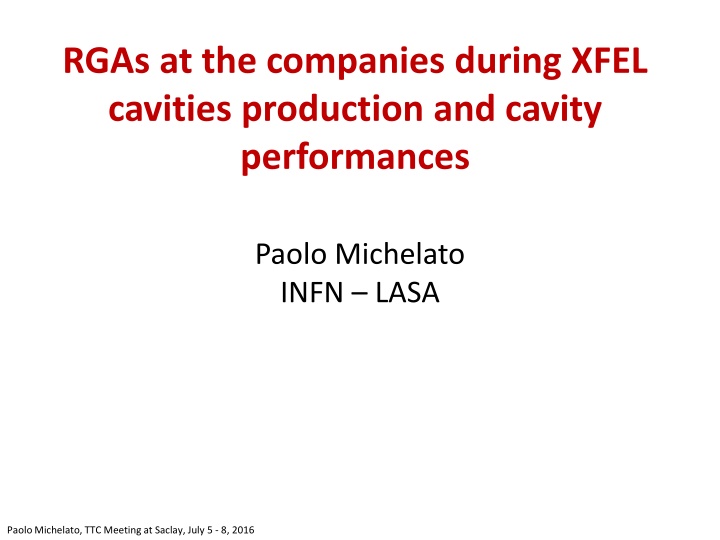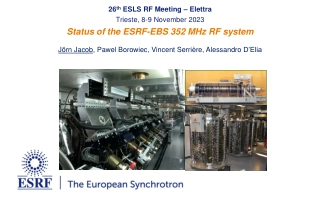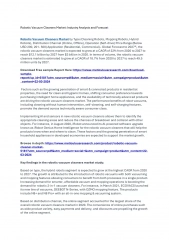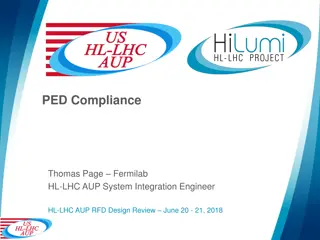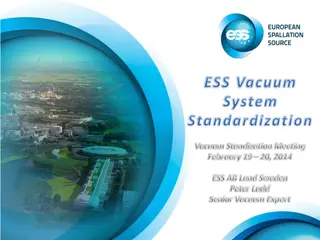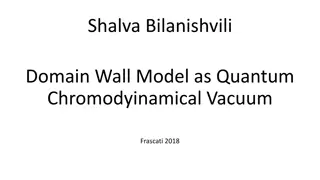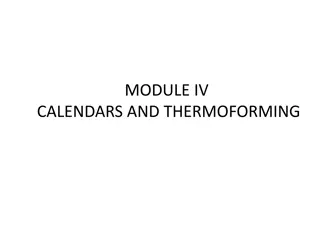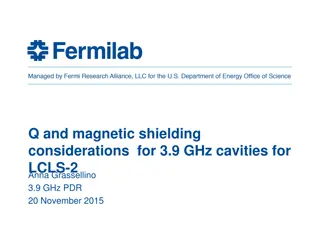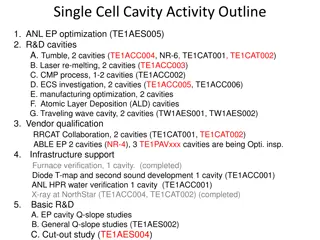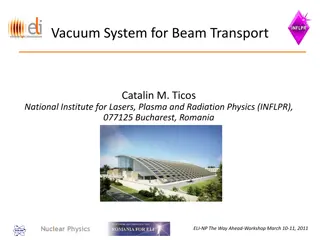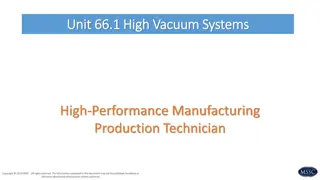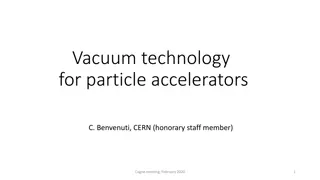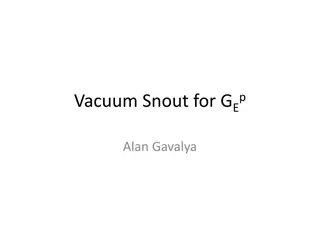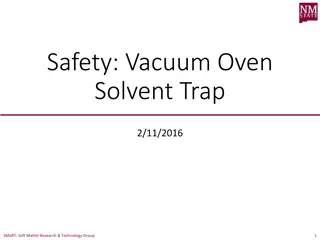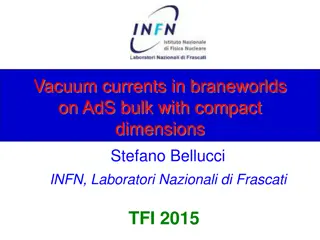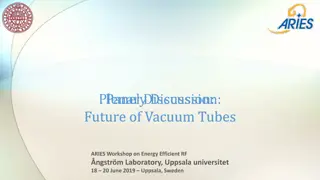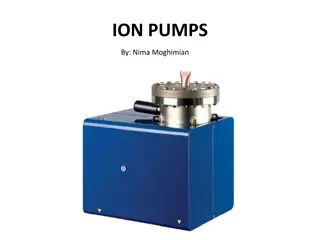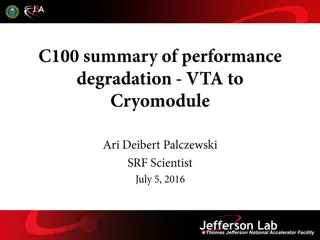Insights into XFEL Cavities Production and Vacuum System Challenges
The discussions at TTC Meeting in Saclay shed light on companies' experiences during XFEL cavities production, revealing operational challenges related to vacuum plants and RGAs. The use of different firm RGAs resulted in distinct effects on RGA behavior, affecting signal/noise ratio and calibration operations. Accumulation of impurities in vacuum systems raised concerns about maintaining vacuum quality. Similar experiences and solutions were sought from other labs. The SPSV system utilized by firms for XFEL cavities showed a common architecture and technique, emphasizing dry primary pumps and large MFCs.
Download Presentation

Please find below an Image/Link to download the presentation.
The content on the website is provided AS IS for your information and personal use only. It may not be sold, licensed, or shared on other websites without obtaining consent from the author.If you encounter any issues during the download, it is possible that the publisher has removed the file from their server.
You are allowed to download the files provided on this website for personal or commercial use, subject to the condition that they are used lawfully. All files are the property of their respective owners.
The content on the website is provided AS IS for your information and personal use only. It may not be sold, licensed, or shared on other websites without obtaining consent from the author.
E N D
Presentation Transcript
RGAs at the companies during XFEL cavities production and cavity performances Paolo Michelato INFN LASA Paolo Michelato, TTC Meeting at Saclay, July 5 - 8, 2016
General comments on vacuum plants used for XFEL cavity production Unusual operational conditions: many pumping and venting operations, in some cases many tens/week. Consequences and actions a) Impact on system reliability, e.g. shorter lifetime of TMP and of scroll pumps with respect to usual operative conditions. Service must be done more frequently than foreseen, great attention to precursor of failures (noise, bad vacuum, etc) Paolo Michelato, TTC Meeting at Saclay, July 5 - 8, 2016
What about RGAs: 2 main effects Companies used quite similar process for cavities production. Same detergent, similar process for main EP, etc The two companies used two different firm RGAs and different w.r.t. the Saclay and DESY ones Different effects were visible in RGA behaviour. a) In one company unusual peaks propagates all over all RGAs. Peaks are abnormal 32 mass , 64, 77, 78, etc a) In the second company RGA SEM sensitivity large decrease (at least in one firm, using RGA with MCP electron multiplier). Sum of the values of pp doesn't give the total pressure, error could be orders of magnitude! Signal/noise ratio reduced! Frequent calibration operation or use of RGA as a percent meter or ion current meter and normalization is done later. Fixed (partially) using a valve on the RGA. Paolo Michelato, TTC Meeting at Saclay, July 5 - 8, 2016
Well known problem! But not for order of magnitude in few months! Someone had similar experience? Janez Setina, Vacuum Symposium 2011 Paolo Michelato, TTC Meeting at Saclay, July 5 - 8, 2016
General comments on vacuum plants used for cavity production Unusual operational conditions: many pumping and venting operations, some tens/week. Consequences and actions a) Accumulation of impurities: all times the system will pump a new chamber, the cavity with its amount of contaminants. If they are transferred to the vacuum system, for instance during 800 C or 120 C treatment, and they have a low vapor pressure, they could be accumulated on the vacuum system. Transfer mechanism of these compounds could be intricate, due to memory effects. Vacuum quality becomes worst. To avoid and / or control this effect, a bake out (120 C) could help a lot maintaining the vacuum systems more clean (done in one firm). ANY SIMILAR EXPERIENCE IN OTHER LABS? Paolo Michelato, TTC Meeting at Saclay, July 5 - 8, 2016
SPSV system at the firms for XFEL cavities Both firms use a similar architecture and technique Dry primary pump Hybrid TMP (High compression ratio for He) Large MFC to control gas throughput in the pumping line Small MFC for the venting High quality (6.0) filtered (40 nm) gas for venting, Ar or N2 Diffuser on the venting line (3 nm) Optimized timing strategy for reducing pressure bumps (valves) RGA on the high vacuum side Dedicated commercial He mass spectrometer for leak detection connected on the TMP discharge line 10-9 mbar range Cal leak (specs leak rate < 1x10-10 mbarl/s) PLC controlled, all data are stored in a server. Paolo Michelato, TTC Meeting at Saclay, July 5 - 8, 2016
EZ slow pumping slow venting system Courtesy EZ Paolo Michelato, TTC Meeting at Saclay, July 5 - 8, 2016
SPSV system at LASA for the 3.9 cavities Reduced number of cavities: 10 x 3.9 GHz for the third harmonic system Different strategy used with respect to usual SPSV: forevacuum pump is stalled during first part of pumpdown by the flow coming through the venting line. After the equilibrium conditions are reached (few tens of seconds, i.e. the same throughput in the pump and in the venting line, no pressure change) the venting MFC start to reduce its opening and therefore pressure is going down. Advantages: reduced pressure bump, MFC are already operative when the pressure start to decrease. Paolo Michelato, TTC Meeting at Saclay, July 5 - 8, 2016
RGA and vacuum quality: some comments Hydrocarbon free vacuum, for the XFEL, is defined when the ratio between the total pressure, as the sum of partial pressures, and the highest contaminant partial pressure is over a factor 1000. Drawbacks using this definition: if total pressure is quite low, as after the 120 deg heat treatment, the partial pressure of contaminants is quite low as absolute value, but could be significant with respect to the total pressure (> 1/1000). Effects of contaminants are related to their partial pressure absolute values and not (directly) to their ratio with the total pressure. It would means that vacuum quality would be better if the partial pressure of water or mass 28 is higher, maintaining constant the partial pressure of contaminants! Moreover there is the problem of SEM degradation Paolo Michelato, TTC Meeting at Saclay, July 5 - 8, 2016
RGA spectra interpretation and contaminants In one company many spectra anomalous mass 32 high, wrt air leak (but no leak!) Mass 64: may be sulfur, but the relative isotopes abundance for mass 32 and 34 are not in good agreement with mass 64. Sulfur concentration in the ethanol is quite low. Some unusual compounds: around mass 50, 58, 78, 79 and 91 Impurities are resident in the vacuum system: no significant change of pp opening and closing cavity valve. Sources: in my opinion some low concentration contaminants that are accumulated in the vacuum system, that have a low vapor pressure and that are difficult to be removed. As for phthalates, long chain alkanes, etc. Investigation on UPW and ethanol are under way. Paolo Michelato, TTC Meeting at Saclay, July 5 - 8, 2016
RGA spectra: sensitivity loss of order of magnitudes End of 800 C cycle P TOT: few E-7 mbar Paolo Michelato, TTC Meeting at Saclay, July 5 - 8, 2016
RGA spectra: some example At the end of the 120 C treatment, total pressure 3x10-8 mbar
RGA spectra: some example 77, 78 55, 56 64 At the end of the 120 C treatment, the final treatment. Total pressure 3x10-9 mbar. Contaminant level is in the 10-12 mbar range. Paolo Michelato, TTC Meeting at Saclay, July 5 - 8, 2016
RGA spectra: some example 32! 77, 78 50 - 58 64 91 Intermediate leak check, after the 800 C annealing Total pressure: 5x10-7 mbar Paolo Michelato, TTC Meeting at Saclay, July 5 - 8, 2016
RGA of one of last XFEL cavity, final clean room pumping before 120 C Paolo Michelato, TTC Meeting at Saclay, July 5 - 8, 2016
RGA of one of last XFEL cavity, during 800C, end of treatment
Effects on cavities? Up to now, we are sure that trivial problems as vacuum system malfunctioning, human error, not correct venting, etc produces dramatic effects on the accelerating field. One cavity vented with not filtered air had shown an accelerating gradient of few MV/m while, after HPR, the cavity was completely restored. Up to now, from preliminary investigations, no correlation had been found between the partial pressure of contaminants and the cavity performances. Why differences between two cavities treated together? Or one just after the other? While differences in the accelerating gradient could be caused by human factor (FE) what is the reason for Q 0 differences also at low field? Good question Paolo Michelato, TTC Meeting at Saclay, July 5 - 8, 2016
Effects on cavities? Multivariate analysis had shown no correlation between contaminants peaks (masses 32, 34, 56, 64, 77, 78) in the last pumping and 120 C with respect to cavities performances. For instance in one company cavities are 120 C treated two by two (twins). Different behavior also between twins cavities. No correlation between Q0 and max field with impurities. Paolo Michelato, TTC Meeting at Saclay, July 5 - 8, 2016
RGA limits EXFEL (change request accepted) In order to reduce the number of NCRs, we temporary accepted to change the rule for RGA acceptance. The reference pressure is calculated as the sumof the partial pressures of the main peaks of the spectrum: Mass 2, Hydrogen Mass 18, Water Mass 28, Nitrogen, CO Mass 32, Oxygen Mass 40, Argon Mass 44, Carbon dioxide Change request accepted for EXFEL: Lowering the required ratio between partial pressure and reference value from 1:1000 to 1:300 . Paolo Michelato, TTC Meeting at Saclay, July 5 - 8, 2016
RGA done at the end of 120C final treatment T: room temperature Tot pressure (BA gauge): 2.9e-9 mbar Reference pressure: 3e-9 mbar 1:300 1:1000
RGA done at the end of 120C final treatment T: room temperature Tot pressure (BA gauge): 3.5e-9 mbar Reference pressure 1:300 1:1000
Mass 64, spectra at room temperature end of 800C furnace treatment Mass 64 behavior vs number of treatments. Ethanol change (blue arrow), cryopump cleaning (red arrow), cavity with Ethanol + HPR (brow arrow) Paolo Michelato, TTC Meeting at Saclay, July 5 - 8, 2016
Mass 64, end of 120C final treatment, last spectra at room temperature MASS 64 Treatment # Paolo Michelato, TTC Meeting at Saclay, July 5 - 8, 2016
